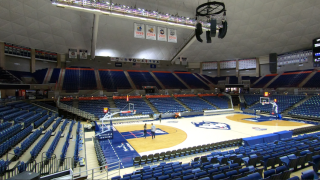
On Super Bowl Sunday, 117 million people were expected to tune in to the big game. Despite finger foods, parties and creative commercials, it is going to be a much more memorable experience for the 70,000 people who will be watching in-person at the stadium.
That is according to a new study out of UConn that shows there is nothing like the live experience for sports fans.
It was conducted at Gampel Pavilion, where one is sure to hear cheers, applause, and the roar of fans at a UConn basketball game.
"So many people around the world care deeply about sports!” Dimitris Xygalatas, UConn Associate Professor of Anthropology, said.
Get top local stories in Connecticut delivered to you every morning. Sign up for NBC Connecticut's News Headlines newsletter.
You might feel like being courtside puts watching sports on a new level and now the research proves that.
The paper, “Being in a Crowd Bonds People Via Physiological Synchrony,” was published in Scientific Reports last month. The study compares how fans react when watching a game on television and when they are watching it live.
“We did this here in Gampell Pavilion, as well as in my lab where people were watching the same games on television,” Xygalatas said.
Local
Xygalatas and his team followed 182 Husky fans throughout the 2016-2017 men and women’s basketball season. They analyzed data from 26 games, where each fan wore a sensor.
“Those devises allowed us to measure people’s heart rates, their breathing rates, how much they moved,” Xygalatas said.
Previous research that Xygalatas has done indicates when people’s hearts synchronize, they are emotionally connected.
“People watching this game live in the stadium, being part of this large group, their heart rates synchronized more than groups of people who watch the same game on television,” Xygalatas said.
That indicated to the research team, when it comes to watching sports, nothing can compete with being part of the crowd.
“The experience of watching a game live is fundamentally different from watching the same game on television,” Xygalatas said.
The researchers also took into account other factors happening in the game, things like dunks, three-pointers, and lead change. They found that even accounting for those factors, it was still watching with a crowd that created the greatest excitement in fans.
"Although those aspects of course are important, in shaping the experience of the game, none of them are as important as being in the stadium itself,” Xygalatas said.
The implications go beyond sports.
“Concerts, and theatrical performances. Things like demonstrations and political rallies,” Xygalatas said.
He says this is especially true as we enter the third year of a pandemic.
“This is a time when we can’t have those events,” he said. “It’s been devastating for so many people.”
Xygalatas says these findings can inform governments and businesses considering whether to remain open in light of COVID-19. The findings also highlight the importance of improving virtual reality to better let people connect as the pandemic continues.
"Those online technologies that we have, they’re not there, at least there yet. They cannot produce the equivalent experience.” Xygalatas said. “By studying this further, hopefully we’ll be able to understand how to improve those technologies to get a little bit more of that collective experience that we get from watching the event in person.”



